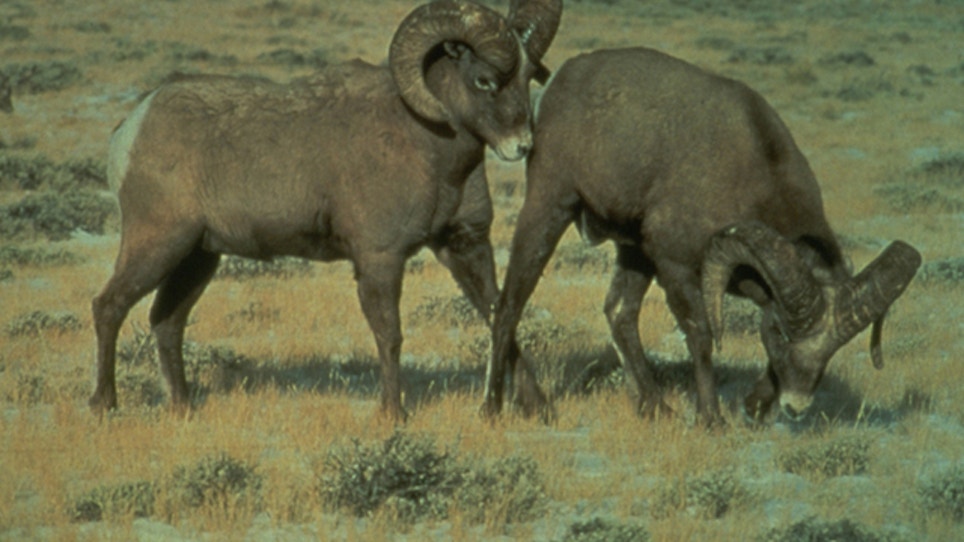By CHRISTINE PETERSON | The Casper Star-Tribune
JACKSON, Wyo. (AP) — The female bighorn sheep looked like two sacks of potatoes as the helicopter lowered them to the ground. Blindfolded and hobbled, they stayed motionless while a crew of wildlife biologists, game wardens and a veterinarian ran to them to begin testing.
Five sets of hands worked on the first ewe. Someone took her temperature: 101.7. A game warden held her down.
Hank Edwards, a wildlife disease specialist with the Wyoming Game and Fish Department, swabbed her tonsils, nasal passage and ears.
Another person fit her with two radio collars.
Within minutes, the group carried her to the bottom of a rocky hill and let her go.
Sheep No. 12 was one of six female bighorns captured, tested and collared Sunday near Jackson as part of a multistate effort to better understand what's killing the animals.
Experts know pneumonia often brings death, but they want to know what combination of bacteria, parasites, habitat, weather or overcrowding makes them susceptible to the deadly bacteria.
"How come they can live with these pathogens most of the time and then all of a sudden tip over?" Edwards asked. "What is tipping point here?"
Bighorn sheep, a symbol of high country in the West, historically roamed most of Wyoming's land, said Kevin Hurley, conservation director for the Wild Sheep Foundation and former bighorn sheep program coordinator for the Wyoming Game and Fish Department.
A combination of unregulated hunting more than a century ago, habitat fragmentation and disease transmission from domestic sheep killed thousands of bighorns and restricted their ranges to only the most rugged and undeveloped terrain.
Even though unregulated hunting has stopped, bighorn sheep remain susceptible to disease, Hurley said.
"These are very robust, very rugged critters that live in such incredible places, but they're extremely wimpy from a respiratory standpoint," he said. "You glance at them sideways, they might topple over."
Wildlife managers started working in the 1940s to keep herds healthy, removing extras from herds that grew too large for their habitat and placing them in areas where herds no longer flourished.
But despite their best efforts, even some of the heartiest populations suffered massive die-offs.
Wyoming's Whiskey Basin herd near Dubois went from 1,300 animals to 650 in the winter of 1990 and 1991. The temperatures stayed well below zero, and snow pummeled the ground during mating season, when rams were most vulnerable.
For the next 20 years, lambs didn't survive as well as they had in the past.
The Jackson herd has a similar story. About 500 animals lived near the Gros Ventre Mountains until the winter of 2001 and 2002, when about 40 percent died.
The population began to recover, only to dip again in 2010 and 2011, said Doug Brimeyer, wildlife management coordinator for the Jackson and Pinedale regions.
Wyoming has about 6,500 bighorn sheep today. The number is strong compared with that of other Western states, Hurley said, but it's still a long way from its historical norm.
Until recently, Game and Fish didn't have the resources or technology to track and identify pathogens in bighorn sheep, said Edwards, the biological disease specialist.
The Jackson trapping was part of a three-year study with Colorado, Montana and Wyoming to track exactly what bugs occur in which herds of sheep. The scientists also tested sheep near Dubois, Cody, Saville Canyon and the Black Hills.
"We're hoping at the end of three years of surveillance, and this is the second of three years, that we will have enough information that we will start to make some meaningful comparisons," Edwards said.
Scientists know sheep carry some of the pathogens without causing sickness or death. They don't know if it is another introduced bug that kills the sheep or if it is a change in weather or habitat or some combination of those.
"This is not going to be an easy puzzle to solve," Edwards said. "This is a puzzle that many states have been working on for many years, and to my knowledge this is the first time this grand comparison has been made."
Biologists took blood and fecal samples during testing and swabbed the sheep's nasal passages, ears and throat to test for pathogens. They also gave them antibiotic and antiparasitic shots.
All of the sheep were fitted with tracking collars to allow Game and Fish to follow the animals' movements. Knowing where they go, what habitat they use, what their migration patterns are and whether they interact with other wild sheep will help scientists better understand their illnesses, Brimeyer said.
After being released from the helicopter, some of the sheep bolted to the top of the hill without a backward glance. Others stopped periodically to look at their captors before disappearing into the rocks.
Information: Casper (Wyo.) Star-Tribune, www.trib.com






